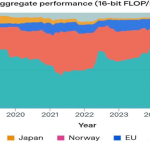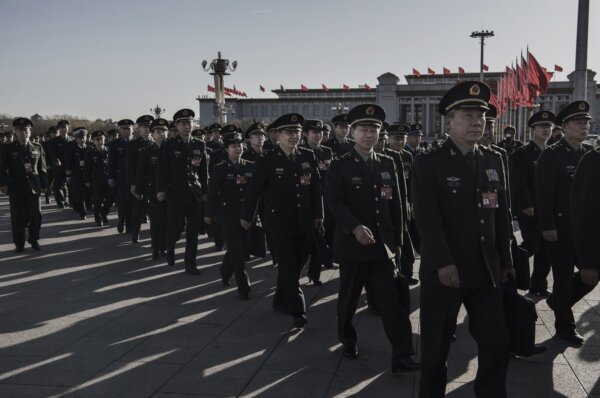‘The republic is being gutted from within by talent pipelines, lobbying arms and diaspora operatives loyal to a foreign agenda’
WND By Amanda Bartolotta

The Indian government does not hide its intentions. It does not cloak its agenda in diplomatic vagueness or cultural goodwill. On the contrary, India has made one fact abundantly clear: it views its global diaspora as a state-controlled asset, a tool of national policy and an instrument of foreign influence.
The Indian government has built one of the most extensive and coordinated diaspora engagement strategies in modern history, one that now plays a central role in India’s global rise. Unlike other nations that merely celebrate their emigrant populations, India has institutionalized a system designed to leverage its overseas citizens for strategic national gain.
To put it simply India has built a state-backed infrastructure specifically designed to mobilize its overseas population as a tool of strategic leverage.
In the process, Indian-origin individuals embedded in American institutions are playing increasingly pivotal roles in influencing U.S. policy, offshoring economic opportunities and redirecting American resources to support India’s geopolitical ambitions.

A state-engineered diaspora strategy
According to The United Indian the Indian diaspora is viewed as a global force capable of swaying political outcomes in host countries.
The publication boasts that Indian-origin communities have driven India’s development through remittances, capital inflows and transfers of technical knowledge from abroad.
More critically, it calls for this global community to be intentionally positioned in key business, policy and academic roles, not to integrate into their host nations, but to serve India’s broader national interests.
This is not just pride in national identity, it’s a blueprint for foreign influence.
India’s Ministry of External Affairs openly acknowledges that investments from Non-Resident Indians (NRIs) account for nearly 35% of the country’s total foreign direct investment (FDI) inflows.

To deepen its reliance on foreign capital and consolidate control over its global diaspora, the Indian government has constructed a sophisticated system of legal, financial and emotional loyalty, one deliberately designed to turn overseas Indians into agents of national advancement.
Through initiatives like Pravasi Bharatiya Divas (PBD) and NRI-targeted investment schemes were explicitly designed to turn diaspora wealth into a national development engine, not just for economic growth, but for India’s geopolitical rise.
While India explicitly prohibits dual citizenship, it has created a legal workaround: the Overseas Citizenship of India (OCI) program, though not true citizenship, OCI status grants foreign nationals of Indian origin lifetime visa-free entry, unrestricted access to India’s economy, educational institutions and property markets (excluding agricultural land) and rights nearly identical to those of NRIs. This structure allows millions of Indian-origin U.S. citizens and green card holders to operate across borders, fully integrated into India’s economic system while retaining the legal protections and privileges of their host countries.
Under India’s Overseas Citizenship of India (OCI) framework, many prominent Indian-origin Americans, including those in politics, business and technology, are eligible for OCI status based on Indian parentage, ancestry, or prior Indian citizenship. For example, Vivek Ramaswamy, now running for governor of Ohio after a presidential bid, qualifies as the child of an Indian citizen. Microsoft CEO Satya Nadella qualifies as a former Indian citizen. Despite holding U.S. citizenship, individuals like Ramaswamy and Nadella can legally obtain OCI status, which allows them to live, work, invest and exercise significant influence in India without relinquishing their American nationality. This dual access positions them as powerful cross-border actors who can simultaneously shape U.S. and Indian interests, making them instrumental to India’s broader geopolitical and economic strategy.
But the design goes deeper. Many of these individuals, despite holding U.S. citizenship or even government security clearances, remain closely embedded in India’s strategic and policy ecosystem.
A blueprint for global leverage
India openly admits that its relationship with the diaspora is not incidental or symbolic, but strategic. This means all engagement, whether financial, educational, or political, is aimed at securing tangible benefits for India, including influence operations, foreign lobbying and economic leverage.
India not only uses the diaspora to bring resources into India, but also seeks to embed and expand Indian labor into foreign economies, particularly through workforce pipelines (H-1B, L-1, OPT), often facilitated by state partnerships and corporate MoUs.
India is actively designing incentive structures and policy tools tailored to different segments of the diaspora. These “customized solutions” include visa rights, investment opportunities and educational access in India, all meant to bind the diaspora more tightly to India’s economic system.
India refers to its diaspora as “investible,” confirming that it views them as resources to be deployed for national gain. This includes their:
- Intellectual capital (tech CEOs, academics, scientists)
- Political influence (elected officials, donors)
- Financial assets (remittances, venture capital)
India’s diaspora incentive structure, powered through the OCI framework, creates the conditions for state-enabled insider trading. This system functions as a form of state-enabled economic espionage. OCI holders are encouraged to influence foreign policy and investment toward India and then personally benefit from those policies and deals using their exclusive access and legal status in India. This isn’t just soft power, its economic manipulation backed by legal infrastructure.
This dual-access framework is not available to average Americans or other foreign nationals, it creates an elite class of cross-border actors who can align their political power in one country (e.g., the U.S.) with financial returns engineered through policy alignment with another (India). By embedding Indian-origin individuals in powerful U.S. institutions and simultaneously offering them privileged access to India’s economic and legal system, India has created a global influence apparatus that bypasses traditional oversight, ethics rules and financial disclosure norms.

India openly acknowledges that it is leveraging the skills, influence and corporate positions of Indian-origin professionals abroad by offering incentives and privileges, including OCI status, to pull them into its domestic development agenda. This includes knowledge transfers in tech, governance and education. It confirms that India’s diaspora policy is not passive, it is designed to extract intellectual capital from abroad to fuel India’s rise. This aligns with the pattern of Indian-origin tech CEOs (e.g., Sundar Pichai, Satya Nadella) driving investment, R&D and infrastructure into India while offshoring jobs from the U.S.
India views overseas Indians as a pipeline for financial capital, not just through remittances but through structured philanthropy aligned with government goals.

The reference to the Foreign Contribution Regulation Act (FCRA) reveals that India wants to control and centralize foreign-origin funding while maintaining legal command over where that money goes, which means the OCI status is not just about cultural connection, it’s a legal mechanism.
India sees its diaspora, especially those in the U.S. as influence agents in global forums. It explicitly seeks to engage diaspora professionals in advocacy, public policy and reputation-building, positioning them as unofficial diplomats. India admits it is deliberately organizing the diaspora to shape international narratives, policy perspectives and strategic alliances. This directly relates to how U.S.-based politicians, CEOs and institutional leaders of Indian origin are used to push India-friendly policies, suppress criticism of India and amplify India’s soft power in Western governments and institutions.

“Positioning India as a preferred source country for economic migration…”
This is a direct admission that India is intentionally marketing itself as a labor-exporting superpower, leveraging bilateral and corporate partnerships to flood foreign markets with Indian workers. This matches the U.S. visa manipulation via H-1B, OPT, L-1 and green card pipelines. India is structuring labor migration as a national strategy, not a side effect of globalization.
“Facilitate Overseas Indians and Indian businesses to invest and share learnings…”
This line reveals a long-term plan to embed Indian nationals and companies inside foreign economies, particularly those with strategic importance. The India government is encouraging Indian-Origin individuals to invest abroad on India’s terms, enable Indian businesses to gain control and visibility in markets and use diaspora networks to export India’s development model into other countries. This reinforces how OCI holders and Indian-origin executives in the U.S. are vehicles of Indian economic influence, spreading India-centric trade practices, tech standards and labor norms.
Leveraging American positions of power

At the center of this effort are Indian-origin power brokers embedded in global business and technology. Many of today’s most powerful global technology companies are led by Indian-origin CEOs, figures who have not only climbed to the top of American corporate ladders, but who have also played critical roles in redirecting resources, innovation and workforce opportunity toward India. These individuals are celebrated in India not just as successful executives, but as strategic assets furthering the country’s national agenda.
This strategic alignment has led to a clear pattern under their leadership, U.S. companies have prioritized Indian markets, labor forces and R&D hubs, while laying off American workers, offshoring critical operations and re-engineering workforce pipelines to favor India’s rise.
Sundar Pichai, CEO of Google, has directed over $10 billion into India through the “Digital India” initiative. Under his leadership, Google established major R&D hubs in Bangalore and Hyderabad and partnered with the Indian government to develop language infrastructure and AI systems. These moves have accelerated India’s dominance in digital infrastructure while moving research and innovation jobs out of the United States.

Satya Nadella, CEO of Microsoft, announced a $3.3 billion investment in India’s cloud and AI ecosystem in 2024. This came as Microsoft conducted significant layoffs in the U.S. Nadella has actively expanded India’s role in Microsoft’s global delivery model, turning India into a backbone for the company’s engineering, operations and customer service arms. His strategic alignment with India’s government has made Microsoft a central partner in the country’s AI and education initiatives.
Parag Agrawal, former CEO of Twitter, promoted India as a key growth market and increased India-specific staffing and engagement with the Indian government. During his tenure, Twitter became more compliant with India’s regulatory frameworks, expanding its domestic political utility while softening its global stance on free speech.

Shantanu Narayen, CEO of Adobe, has scaled Adobe’s India operations into a global R&D hub and has openly praised India’s tech talent and infrastructure. He continues to grow Adobe’s footprint in India while supporting government-aligned initiatives related to digital creativity, education and data frameworks.
Arvind Krishna, CEO of IBM, has overseen the company’s transformation into a consulting-heavy enterprise with a massive presence in India. Today, IBM employs more people in India than anywhere else in the world. Krishna has shifted core business operations and product development to India, enabling a long-term offshoring model that has reduced American IT and engineering headcount.
Raghu Raghuram, CEO of VMware, has expanded VMware’s engineering and DevOps operations in India. The company’s India teams have become central to cloud product development and global customer support functions.
Anjali Sud, former CEO of Vimeo, advocated a remote-first workforce strategy that allowed Vimeo to scale its engineering presence in India. Her leadership coincided with Vimeo’s partnerships across India’s media and technology ecosystem.
Nikesh Arora, CEO of Palo Alto Networks, has overseen the launch of major cybersecurity engineering hubs in India. His strategy positioned India as a global center for cyber talent, driving product development from Indian campuses while reducing reliance on U.S.-based teams.
Revathi Advaithi, CEO of Flex, shifted manufacturing and logistics operations to India as part of the company’s realignment under global supply chain pressures. She has actively supported India’s “Make in India” industrial policies, strengthening the country’s manufacturing base.
George Kurian, CEO of NetApp, has positioned the company’s India arm as a global technology and engineering hub. NetApp India handles core storage product innovation and services, deepening the country’s role in high-tech infrastructure.
Sanjay Mehrotra, CEO of Micron, has played a leading role in developing India’s semiconductor industry. He led Micron’s $2.75 billion investment in a semiconductor assembly and testing facility in Gujarat, an initiative heavily subsidized by the Indian government. While India benefits from new chip capabilities, U.S. semiconductor expansion efforts have faced cuts and delays.
These aren’t isolated cases, they are coordinated outcomes. India’s immigration strategy, in tandem with its diaspora engagement playbook, has used the U.S. work visa system as a delivery vehicle, flooding American companies with Indian nationals while displacing U.S. workers at scale.
According to The United Indian, the global economic footprint of Indian diaspora-led businesses now exceeds $3 trillion annually. This is not merely success, it is state-backed leverage.
In summary, these Indian-origin CEOs are not merely individual success stories. They are key actors in India’s global strategy, channeling American capital, jobs and technologies to strengthen India’s economic, digital and geopolitical position, often while U.S. workers and industries suffer the consequences. Their positions at the helm of U.S. corporations have made them ideal conduits for India’s long-term national ambitions.
Indian Multinational Corporations: The corporate engine of India’s foreign agenda

While Indian-origin CEOs embedded in U.S. corporations have become symbols of influence and strategic alignment, it is Indian multinational enterprises (MNEs), notably Tata Consultancy Services (TCS), Infosys, Wipro, Cognizant, Tech Mahindra and HCL Technologies, that serve as the operational arms of India’s economic expansion and workforce export strategy. These companies have played a central role in advancing India’s national agenda by systematically exploiting the U.S. immigration system, displacing American labor, offshoring sensitive contracts and influencing U.S. policy under the guise of globalization.
These MNEs are not neutral market actors. They operate in lockstep with Indian government ministries, educational institutions and trade bodies to implement India’s global workforce and innovation agenda. Their executives regularly participate in diaspora events like Pravasi Bharatiya Divas and leverage India’s Overseas Citizenship of India (OCI) program to maintain influence over Indian-origin professionals embedded in U.S. companies and agencies.
The offshoring playbook used by these firms, perfected through state incentives and policy coordination, has enabled the transfer of U.S. contracts, research and intellectual property to India-based facilities. TCS and Infosys pioneered this model with 24/7 development centers in Bangalore and Hyderabad. Cognizant, Wipro and Tech Mahindra expanded it by winning U.S. government and corporate deals, then quietly shifting execution to India. Many of these contracts include sensitive data and services once intended exclusively for American use, some even involving defense and healthcare systems.
The damage to American workers is staggering. These firms collectively file tens of thousands of H-1B, L-1 and OPT visa applications every year, undercutting U.S. wages and excluding qualified American applicants. Several have been sued for discrimination, including TCS, Infosys, Cognizant and Tech Mahindra. In one of the most notable cases, Infosys paid a $34 million settlement to the DOJ for abusing B-1 visas to sneak in Indian workers under false pretenses. Others have faced similar accusations of misusing the visa system to sidestep U.S. labor protections and import low-wage labor.
Beyond workforce displacement, these MNEs shape U.S. policy. As members of lobbying bodies like the U.S.-India Business Council (USIBC), they push for expanded visa quotas, intellectual property concessions and trade agreements that benefit India. They also fund diaspora-linked advocacy groups like Indiaspora and USINPAC to influence American lawmakers and normalize India-first workforce policies under the banner of globalization.
These corporations are not simply participants in the global economy, they are tools of India’s national strategy. They have embedded themselves inside America’s digital infrastructure, redirected taxpayer-funded innovation to India and engineered a labor market shift that benefits one nation at the expense of another. Their success represents not just corporate growth, but the successful execution of a geopolitical and economic conquest, one contract, one job and one visa at a time.
Indian-Origin U.S. political power: India Government political access and policy influence in America through diaspora

India has not only exported labor and technology, it has also cultivated political influence in the United States through a growing number of Indian-origin elected officials and civil servants. These individuals, often celebrated by Indian media and government officials as “diaspora success stories,” are increasingly positioned in critical roles across U.S. policymaking, diplomacy, trade and law.
Their prominence is not just a reflection of personal achievement, it’s a strategic asset for India’s foreign policy. The Indian government maintains regular engagement with Indian-origin U.S. lawmakers and public officials. Congress members such as Ro Khanna and Pramila Jayapal have participated in Indian diaspora events and advocated for increased U.S.-India cooperation. U.S. policy changes related to immigration, trade and technology transfer often receive vocal support from diaspora-linked organizations, including the U.S.-India Business Council (USIBC) and Indian-American lobbying groups.
FEDERAL ELECTED OFFICIALS
Kamala Harris, Former Vice President of the United States, is the daughter of Indian-born scientist Shyamala Gopalan. Although Harris identifies more with her African-American heritage publicly, Indian officials and media claim her as a symbol of diaspora power, frequently referencing her as a point of national pride and using her image in Pravasi Bharatiya Divas and India-based political narratives.
Ami Bera, U.S. Representative from California’s 6th District, is the longest-serving Indian-American in Congress. He sits on the House Foreign Affairs Committee and has consistently supported pro-India policy positions, including increased defense and health cooperation. Bera frequently appears at Indian consulate events and receives backing from Indian-American lobbying groups.
Raja Krishnamoorthi, U.S. Representative from Illinois’s 8th District, is known for his vocal support of U.S.-India relations. He regularly engages with Indian consulates, diaspora coalitions and public forums promoting bilateral economic and educational ties. He has endorsed expanding H-1B visas and supports India-centric trade initiatives.
Ro Khanna, U.S. Representative from California’s 17th District (Silicon Valley), is perhaps the most active Indian-origin lawmaker when it comes to coordinating with the Indian government. He has spoken at Indian diaspora forums, participated in trade delegations and met directly with Indian officials to discuss shared tech and labor interests. Khanna plays a central role in maintaining India’s foothold in U.S. tech policy.
Pramila Jayapal, U.S. Representative from Washington’s 7th District, is of Indian origin and chairs the Congressional Progressive Caucus. While she has occasionally criticized India’s human rights record, she remains deeply embedded in India-focused diaspora circles and continues to advocate for South Asian-American representation and visa-related reforms that disproportionately benefit Indian nationals.
Shri Thanedar, U.S. Representative from Michigan’s 13th District, is an immigrant from India and a former entrepreneur. He has positioned himself as a “self-made success story,” drawing significant attention from Indian media outlets that celebrate his electoral victory as a win for the diaspora.
Suhas Subramanyam, elected in 2024 to represent Virginia’s 10th District, became the first Indian-American Congressman from Virginia. His election was hailed by Indian consulates and diaspora PACs as a milestone in expanding Indian-origin political power at the federal level.

STATE & LOCAL OFFICIALS
Aruna Miller, Lieutenant Governor of Maryland, is the first South Asian woman to hold such a high executive office in any U.S. state. Her campaign and inauguration were celebrated in Indian media as an “historic diaspora achievement,” and she maintains active relationships with Indian-American groups.
Ravinder Bhalla, Mayor of Hoboken, New Jersey, made headlines as the first Sikh mayor elected in New Jersey. He has spoken at Indian consulate events and is frequently spotlighted by Indian media outlets promoting diaspora visibility.
Niraj Antani, Ohio State Senator, is the first Indian-American Republican elected to the Ohio legislature. He’s been involved in India-friendly business delegations and has spoken publicly in support of U.S.-India trade alignment.
Jenifer Rajkumar, a New York State Assembly Member, is the first Indian-American woman elected to New York’s Legislature. She’s known for her active participation in Indian cultural celebrations and events organized by Indian diplomatic missions.
Kshama Sawant, Seattle City Council member, is a high-profile political figure of Indian origin. While aligned with socialist and anti-capitalist causes, she has nevertheless been cited in Indian state media as evidence of diaspora reach into American political systems.
Manka Dhingra, Washington State Senator and Deputy Majority Leader, regularly advocates for Indian-American communities and serves as a bridge between Indian diplomacy and state-level U.S. politics.
These Indian-origin officials are not just public servants, they are key nodes in a transnational influence network. Whether by promoting India-friendly trade, championing immigration policies that benefit Indian labor exports, or directly engaging with Indian ministries and consulates, they have become instruments of soft power for a foreign government seeking deeper economic and political footholds in the United States.
The foreign enterprise operating inside American gates
From Silicon Valley boardrooms to Capitol Hill, Indian-origin power brokers, whether CEOs, elected officials, or high-ranking bureaucrats, have quietly but decisively advanced India’s global ambitions from within American institutions. Trusted to represent American interests, many have made decisions that directly expanded India’s economic, technological and strategic reach, often at the expense of American workers, taxpayers and national sovereignty.
Their loyalty is not judged by soundbites. It is revealed in their actions. And India has made its intent explicit. These diaspora figures are not just celebrated success stories. They are strategic tools in India’s foreign policy. The United States, so far, has allowed it.
This must now be addressed with clarity. What happens when American institutions elevate individuals aligned, by birth, benefit, or ideology, with a foreign government? We are already living the answer. From trade deals and education partnerships to immigration policy and infrastructure, Indian-aligned influence has structurally reshaped American systems to favor India’s rise.
When Indian-origin lawmakers push expanded visa quotas or bilateral tech transfers, when corporate executives move jobs and research to India, when academics and nonprofit leaders advise Indian ministries or appear at diaspora summits like Pravasi Bharatiya Divas and when U.S. law firms shape domestic policy for Indian interests, this is not about heritage. It is about strategic alignment. And when that alignment undermines American jobs and weakens national competitiveness, it becomes a direct threat.
What other nation would tolerate foreign-aligned actors influencing its laws, investments and workforce strategy in favor of a rival power? What other government would remain silent as its own institutions are redirected to serve another country’s rise?
While Chinese influence has sparked national security investigations and legislative action, India’s infiltration has been masked by diplomatic charm and the illusion of shared values. But India’s model, built on visa exploitation, diaspora loyalty, intellectual property theft and policy capture, is no less dangerous.
The question is no longer whether this network exists. The question is how long America will allow foreign-aligned operatives to shape its future. Because when India is prioritized over America, that is not cooperation. That is colonization by strategy. And it ends when we say America First. On our soil. In our jobs. And in our government.
The cost to America
The cost of India’s strategy is not hidden in spreadsheets or obscure treaties. It’s written across the hollowed-out factories of the Midwest, the layoffs in Silicon Valley and the flood of foreign resumes that replaced American workers through programs never meant to be abused. It’s embedded in the tech monopolies that now serve as international outsourcing hubs, in the universities captured by foreign talent pipelines and in the policies shaped not for America’s benefit, but for India’s ascendancy.
This isn’t a partnership. It’s conquest through policy, profit and persuasion.
India has weaponized its diaspora, its multinational firms and its manipulated alliances to execute one of the most sophisticated economic invasions in modern history, without a single shot fired. American goodwill, legal loopholes and corporate greed became the tools of surrender.
And what did we lose? Control over our labor force. Ownership of our technology. Direction of our future.
India’s rise has been powered by our decline. Not by accident. By design.
Every job offshored. Every visa that was exploited. Every trade deal tilted in their favor, was a calculated move in a long game we refused to see. And while America slept, India embedded itself inside our institutions, rewrote our rules and positioned its agents to steer our destiny.
This is no longer just a wake-up call. It is a final warning.
The American republic is being gutted from within, not by tanks or missiles, but by talent pipelines, lobbying arms and diaspora operatives loyal to a foreign agenda.
We can either confront this truth now, or watch as America is outsourced, reprogrammed and overwritten … one manipulated visa, one remitted dollar and one “strategic partnership” at a time.
?History will not remember us kindly if we fail to act. This is our line in the sand. America first, or America lost.











